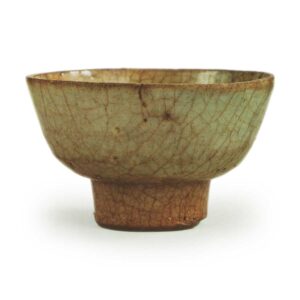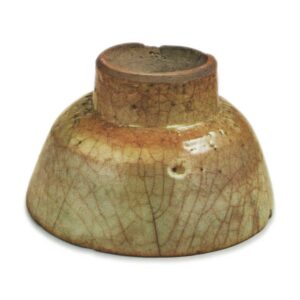

Height: 7.0 – 7.5cm
Diameter: 12.0 – 12.2cm
Outer diameter of foot ring: 5.5 – 5.7cm
Height of foot ring: 2.3 – 2.4cm
This is a celadon bowl made in Fujian Province during the Ming Dynasty. It is a type of celadon that is thought to have been made by the Ningbo ware, but it has no patterns on the inside or outside, and it is a tea bowl that I have never seen before.
At first glance, it looks like a Goryeo tea bowl, with a glaze that is so moist and full of flavor. However, looking at the way it was made, it has a very Chinese feel to it, with a distinctive Chinese style of cutting, so it is definitely Chinese. It is so roughly made that it is hard to imagine that it could have been made by anyone other than a beginner, and it is thought that it was mass-produced as a kind of everyday ware at the time.
In Fujian Province, there seem to have been quite a few kilns that produced celadon porcelain from the Southern Song to the Ming dynasties. The kilns that have been traditionally identified are those in Quanzhou, such as the Wanyuan kiln village, Luhou village, Tingxi in Tong’an county, Shikeng village in Fuqing county, Tangkou in Lianjiang county, and Kuiqi, but there are also kiln sites in Shanyou, Yongchun, Anxi, Longxi, etc., and there are also quite a few other kilns that have yet to be discovered. All of these are celadon ware in the style of Longquan ware, and the large, high foot rings are generally characteristic of Fujian celadon.
We cannot say for sure which of these kilns produced this tea bowl, but looking at the rough workmanship and the large, high foot ring, we think it is almost certainly from Fujian in the Ming period.
Nagasaki is an old port, and various rare Chinese items have come to Japan through it. It is said that in old houses in Nagasaki, there are sometimes vessels that cannot be seen anywhere else, and this tea bowl is also a rare item that has never been seen before, and it is likely that it was chosen by a tea master in Nagasaki in the same way that a tea master in the past would have chosen a tea bowl to use in a tea ceremony. We don’t know who gave the name “Old Friend” to this tea bowl, but it is a name that really suits it.
The body is a rough, semi-porcelain clay with a slight iron content, and it is covered in a thick, semi-transparent glaze with fine air bubbles, and has a rough crackle finish all over. The thick, heavy body has a thick, flat mouth, commonly referred to as a “mountain path”, and the imposing, large, high foot supports the shallow bowl-shaped body. The tatami mat is cut at an angle, and the bottom is also cut deeply at an angle. The clay is exposed below the rim, revealing a faintly brownish burnt color.
The firing is slightly oxidized, and the overall color is loquat-colored, but some parts are slightly reduced, giving it a bluish tinge, and this complex sen-style is one of the charms of this tea bowl.
In this type of Ming-era Fujian blue-and-white porcelain, the inside of the bowl is often covered in a thick layer of celadon glaze, with three eye-shaped impressions. This bowl appears to have been used a lot, as there are circular stains around the inside of the bowl, which have caused it to leak.
There are a few cracks around the rim, and there is one small tear, but it is almost perfect. Originally, it was probably an ordinary, unremarkable bowl, but the complex yuzu pattern and the worn feel of the bowl give it a certain charm.



